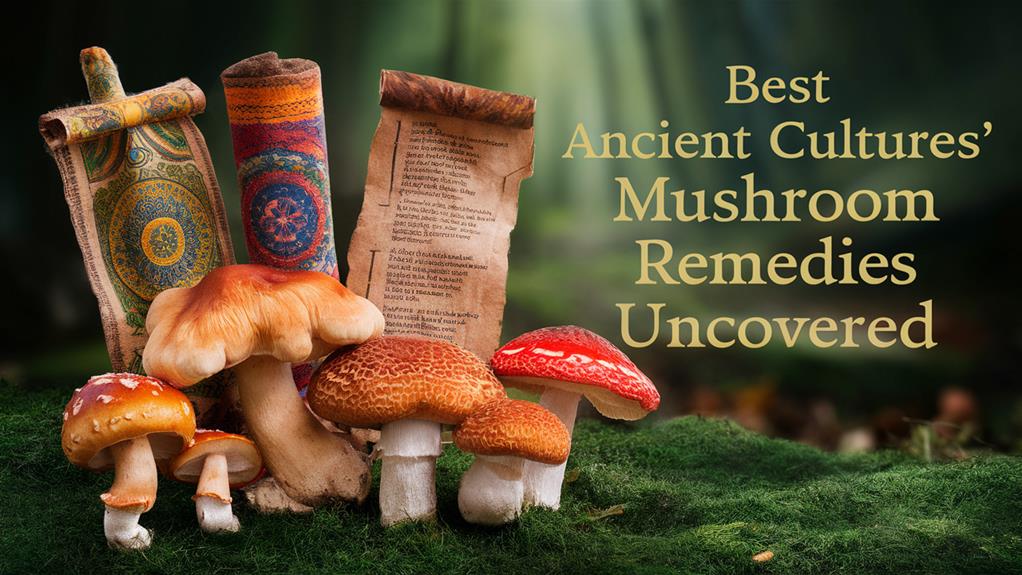
Ancient cultures viewed mushrooms as vital for medicine and spirituality. Egyptians saw them as symbols of immortality, while Greeks recognized their healing and toxic potential. Indigenous North Americans used mushrooms for wound healing and spiritual practices. Vikings relied on hallucinogenic mushrooms to enhance their battle strategies and connections to the divine. Taoists celebrated mushrooms for promoting longevity and balance, and traditional Chinese medicine has valued them for over 3,000 years, focusing on immune health. In South America, shamans used psychoactive mushrooms during rituals for healing and spiritual growth. Discover how these rich traditions continue to influence our understanding today.
Ancient Egyptian Mushroom Practices
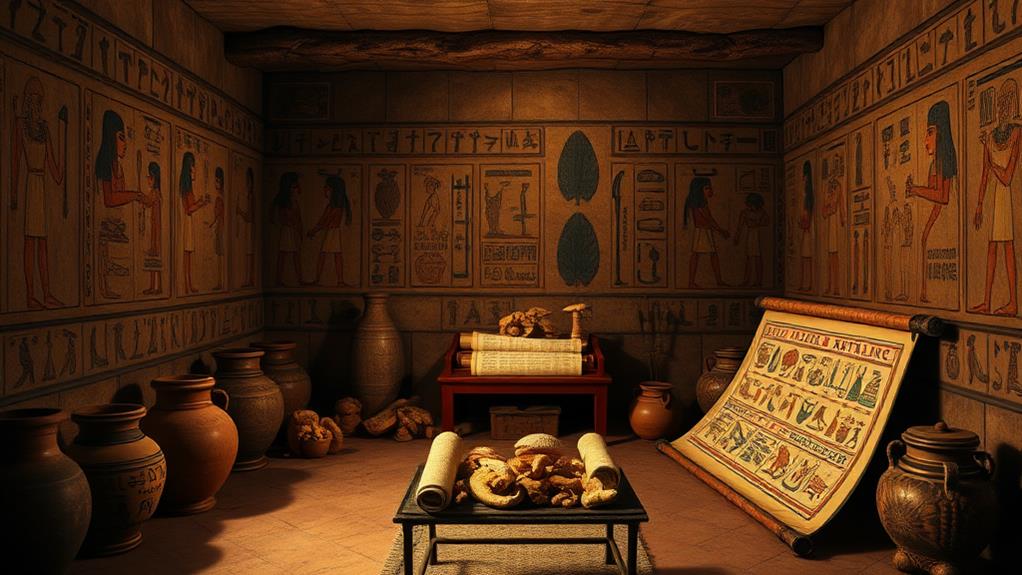
Have you ever wondered why mushrooms held such a revered status in ancient Egypt? The ancient Egyptians believed mushrooms were "sons of the gods," viewing them as symbols of immortality. They considered these fungi a prestigious food, only available to pharaohs and nobles due to their perceived medicinal properties.
In fact, the therapeutic benefits of mushrooms have been acknowledged for centuries, as seen in modern studies highlighting their immune system support. Laws even prohibited commoners from consuming mushrooms, highlighting their connection to wealth and health.
Pharaoh Khufu's fondness for truffles illustrates the royal preference for certain types of mushrooms in this culture. Scholars of ancient Egypt documented the medicinal uses of mushrooms, revealing their significance in traditional medicine. They were used to treat various ailments, showcasing their importance in health practices of the time.
Mushrooms were more than just food; they represented a bridge between the mortal realm and divine health. With their rich symbolism and medicinal benefits, mushrooms played a vital role in ancient Egyptian life, setting them apart from other cultures.
While the Greeks had a more cautious view of mushrooms, often associating them with danger, the ancient Egyptians celebrated these fungi as gifts from the gods, truly embodying the essence of health and immortality.
Greek Philosophical Views on Fungi
In ancient Greece, philosophers grappled with the enigmatic nature of fungi, often classifying mushrooms as plants while questioning their unique growth and reproductive characteristics.
Greek philosophers recognized that mushrooms have a long history of traditional use for both food and medicine, including their role as top medicinal mushrooms known for various health benefits. Hippocrates documented their health benefits, noting both beneficial and toxic properties, reflecting the dual nature of fungi.
Euripides, having faced tragedy from mushroom poisoning, warned society about these risks. He emphasized that while some mushrooms are safe, others can be deadly.
Theophrastus contributed to this understanding by identifying edible species, particularly those growing on dung, demonstrating an awareness of their ecological relationships.
Here are some key insights about Greek philosophical views on fungi:
- Greek philosophers classified mushrooms as plants but were uncertain about their nature.
- Hippocrates highlighted the medicinal benefits and dangers of mushrooms in his teachings.
- Euripides' personal experiences with poisoning shaped societal views on consumption.
- Evidence shows Greeks cultivated certain mushroom species, showcasing early agricultural practices.
Indigenous North American Remedies
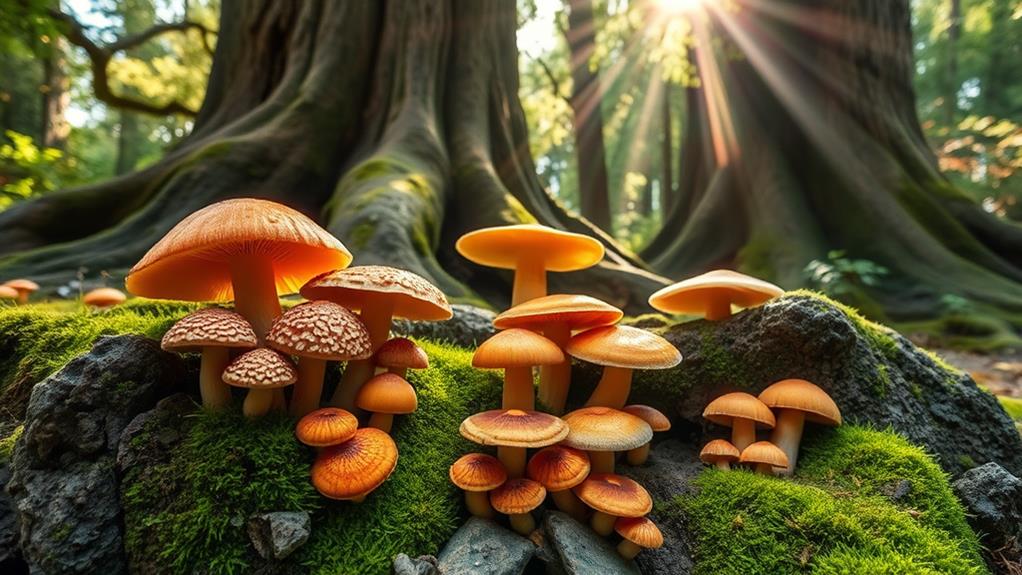
In Indigenous North American cultures, mushrooms play a vital role in traditional healing practices.
You'll find that tribes used specific types like puffballs for wounds and reishi for boosting immunity, showcasing their deep knowledge of these natural remedies.
Reishi mushrooms, known for their immune system support, have been revered for their ability to enhance the body's defense mechanisms.
Moreover, mushrooms often held cultural significance, being woven into spiritual rituals that honored their healing properties and the connection to the earth.
Traditional Healing Practices
For centuries, Indigenous North Americans have turned to mushrooms as vital components of their traditional healing practices. These cultures recognized the unique properties of various mushroom species, integrating them into rituals and remedies. They believed these fungi held spiritual significance, providing a deeper connection to the earth and its healing forces.
- Puffball mushrooms served as effective wound healers, leveraging their natural antiseptic properties.
- The birch polypore mushroom was widely used for its anti-inflammatory and antimicrobial effects.
- Certain tribes embraced psychoactive mushrooms, using them in sacred ceremonies to inspire visions and spiritual insights.
Overall, Indigenous knowledge of medicinal mushrooms reflects a profound understanding of local ecosystems and the potential of fungi.
This rich tradition emphasizes the importance of these natural remedies. By utilizing mushrooms, Indigenous peoples not only treated physical ailments but also sought spiritual healing.
Their practices remind us of the intricate relationship between nature and wellness, showcasing how these ancient cultures harnessed the power of medicinal mushrooms. This heritage continues to inspire modern approaches to health and healing today.
Specific Mushroom Applications
Mushrooms play a crucial role in Indigenous North American remedies, offering a variety of health benefits through their unique properties. For generations, Indigenous peoples have utilized mushrooms to harness their medicinal properties. Puffball mushrooms, for instance, serve as natural wound healers, applied directly to cuts and bruises for their effective healing effects.
The birch polypore mushroom has become a common styptic agent among various tribes, helping to stop bleeding in emergencies. Some tribes brew chaga mushroom into teas, tapping into its anti-inflammatory and antioxidant benefits. This ancient remedy showcases how traditional knowledge can enhance health.
Additionally, reishi mushrooms are celebrated for their ability to enhance vitality and support the immune system, reflecting a deep understanding of these fungi's health effects. The rich cultural relationship with mushrooms highlights the importance of identifying and harvesting specific types, ensuring that the wisdom of the past continues to influence modern practices.
Cultural Significance of Mushrooms
Throughout history, Indigenous North American cultures have revered mushrooms not just for their medicinal properties but also for their profound cultural significance.
These fungi play a vital role in traditional healing practices and spiritual rituals, bridging the gap between the physical and spiritual worlds.
- Medicinal Uses: Puffball mushrooms, for example, were used as natural wound healers due to their antimicrobial properties.
- Spiritual Significance: Certain mushrooms were believed to connect people with the spirit world, enhancing personal experiences.
- Ceremonial Practices: Some tribes used psychoactive mushrooms during ceremonies, fostering communal bonding and deeper spiritual connections.
- Mushroom Foraging: Knowledge of mushroom foraging was passed down through generations, emphasizing the bond between Indigenous cultures and their natural environment.
The integration of mushrooms into various practices highlights their importance beyond mere consumption.
They symbolize a deep respect for nature and its resources, reflecting the rich cultural tapestry of Indigenous peoples.
Viking Uses of Hallucinogenic Mushrooms
Vikings used hallucinogenic mushrooms like Amanita muscaria to enhance their battle strategies and spiritual rituals.
By consuming these mushrooms, they experienced altered states of consciousness that may have fueled the fierce Berserker fighting techniques, allowing them to face their enemies with wild aggression and bravery.
This connection between the mushrooms and their warrior spirit highlights the cultural importance of these natural remedies in Viking society.
Berserker Fighting Techniques
Hallucinogenic mushrooms, particularly Amanita muscaria, played a crucial role in the Berserker fighting techniques of Norse warriors.
These edible mushrooms were consumed to induce altered states of consciousness before battle, enhancing the warriors' ferocity and fearlessness.
When you think about the legendary tales of Viking combat, you might realize that these mushrooms contributed to the Berserkers' near-invulnerability during fights.
- They entered trance-like states, demonstrating incredible strength.
- Consumption was often part of a ritualistic practice, connecting them to their gods.
- Historical accounts reveal that these mushrooms were integral to Viking culture.
- The effects of hallucinogenic mushrooms allowed warriors to overlook pain and fear.
Spiritual and Ritual Practices
Many ancient cultures sought ways to connect with the divine, and the Vikings were no exception. They believed that consuming mushrooms, particularly the species Amanita muscaria, played a vital role in their spiritual and ritual practices. Before battles, warriors would partake in these hallucinogenic mushrooms to induce altered states of consciousness. This practice was linked to the Berserker method, where fighters entered frenzied states, enhancing their bravery and ferocity.
Ethnobotanical studies show that the Vikings used these mushrooms to transcend normal perception, creating a bridge to the spiritual realms. Historical texts suggest that consuming mushrooms helped warriors communicate with their gods, making them feel invincible.
During crucial moments in combat, this connection to the divine was paramount, as it provided them with a psychological edge. These ancient remedies weren't just for physical strength but aimed to elevate their spiritual experience and foster unity among the warriors.
The psychoactive properties of the mushrooms likely contributed to the Vikings' fearsome reputation, allowing them to face their enemies with unmatched courage and ferocity. This intertwining of ritual, spirituality, and the power of nature showcases the depth of Viking culture and their quest for divine connection.
Taoist Traditions and Medicinal Mushrooms
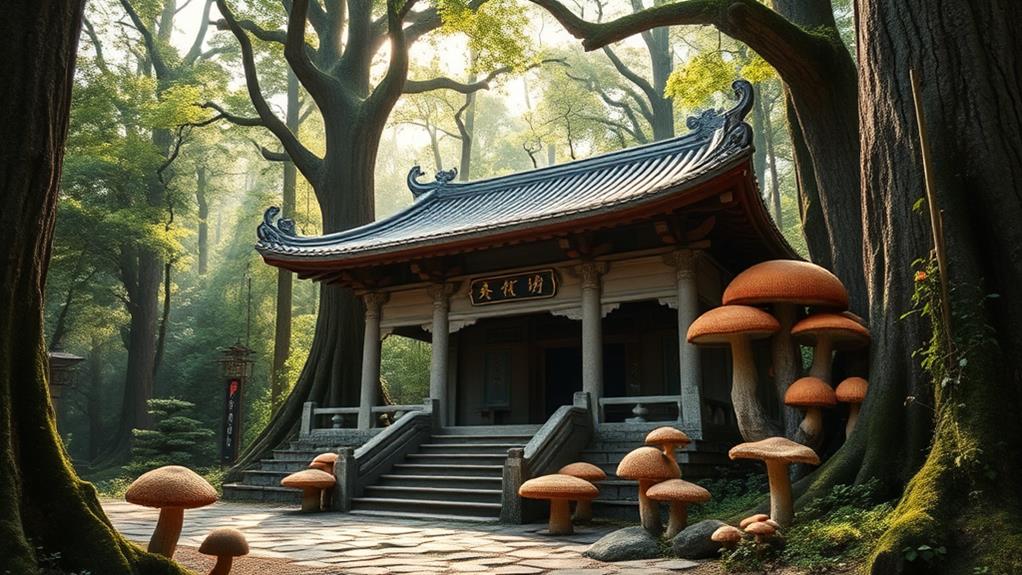
How did ancient Taoist traditions come to embrace medicinal mushrooms as vital components of health and spirituality? Taoist practices viewed mushrooms, especially Ganoderma lucidum, as more than just food; they were symbols of longevity and vitality.
Prominent figures like Tao Hongjing documented their health benefits, leading to a rich understanding of these fungi's role in holistic wellness.
In Taoist traditions, mushrooms were revered for their life-enhancing properties and their connection to spiritual growth. They believed that these medicinal mushrooms could help achieve harmony and balance between the body and mind.
Ancient Taoists integrated these mushrooms into their practices, promoting both physical health and spiritual development.
Here are a few key aspects of this tradition:
- Ganoderma lucidum (Lingzhi): Known for its powerful health benefits, it's often linked to longevity.
- Holistic approach: Taoists understood the interconnectedness of nature and health.
- Spiritual symbolism: Mushrooms were seen as pathways to achieving balance and harmony.
- Vitality enhancement: Mushroom concoctions were used to support meditation and boost energy.
Through these practices, Taoist traditions celebrated the profound impact of medicinal mushrooms on life and spirituality.
Traditional Chinese Medicine Insights
For over 3,000 years, Traditional Chinese Medicine (TCM) has recognized mushrooms as essential allies in promoting health and vitality. TCM practitioners have documented various medicinal mushrooms, like Ganoderma lucidum, or Lingzhi, in texts such as the Shennong Bencao Jing.
These mushrooms are often categorized based on their effects on Qi, or vital energy, with specific types believed to enhance immune health and longevity.
Shiitake mushrooms, for instance, are highly valued not only for their delicious taste but also for their ability to support cardiovascular health.
Reishi mushrooms are famous for their immune-boosting properties, making them a common ingredient in TCM formulations and tonics. These remedies are designed to balance the body's energies and improve overall wellness.
Modern clinical trials and research support the traditional claims regarding the health benefits of these mushrooms. This ongoing scientific inquiry reinforces the significance of medicinal mushrooms in both historical and contemporary practices.
South American Shamanic Mushroom Rituals
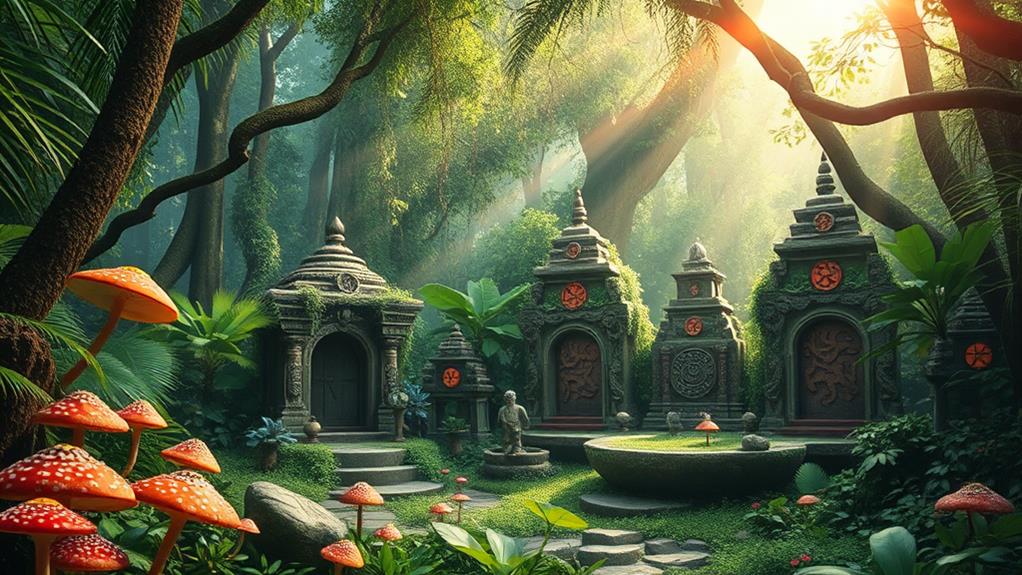
South American shamanic mushroom rituals are profound experiences that tap into ancient traditions, offering participants a chance to explore their spirituality and inner selves. These rituals often utilize psychoactive mushrooms, particularly those containing psilocybin, believed to facilitate spiritual growth and healing. Indigenous tribes like the Mazatec have practiced these ceremonies for centuries, where shamans guide participants on their journeys.
During these rituals, you'll often encounter:
- Specific chants and songs that enhance the experience
- Guided meditations to deepen introspection
- Traditional healing practices for mental and physical well-being
- Significant cultural events, such as rites of passage
As you partake in these shamanic rituals, the psychoactive compounds in the mushrooms can lead to altered states of consciousness. Participants frequently describe these experiences as mystical, leading to long-lasting positive changes in their mindset.
Additionally, these rituals play a crucial role in cultural identity and community bonding, marking important life events. Engaging in South American shamanic mushroom rituals not only promotes healing but also fosters a deeper connection to the divine and to those around you. It's a journey worth exploring for anyone interested in the healing power of nature.
Conclusion
In exploring these ancient cultures, we see how mushrooms played significant roles in healing and spirituality. For instance, the Native American use of psilocybin mushrooms in vision quests shows their deep connection to nature and self-discovery. Today, many are rediscovering these practices, seeking natural remedies for modern stress and anxiety. By understanding these historical uses, you can appreciate the wisdom of our ancestors and possibly find new ways to enhance your own well-being through nature's gifts.
